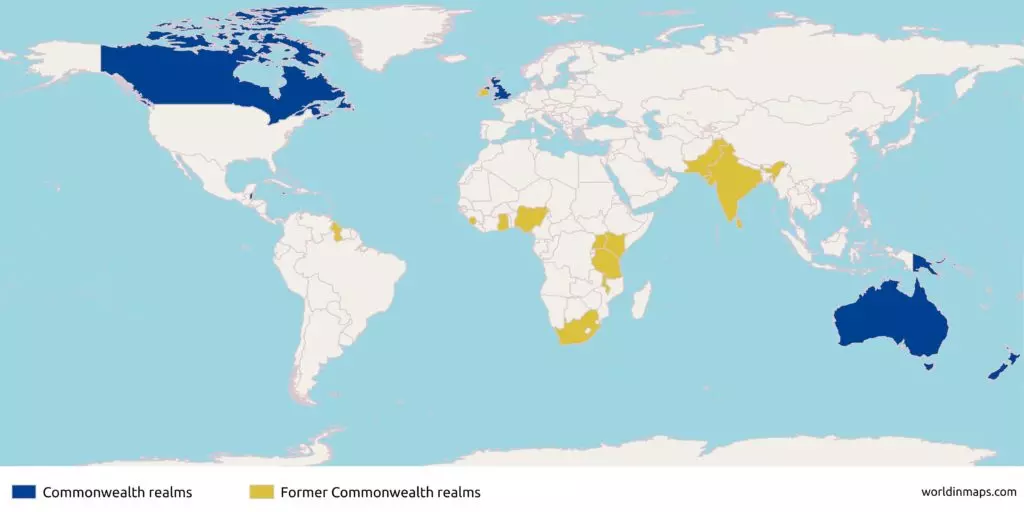Politics | Home / Commonwealth realms
Last update: July, 6 2020
Commonwealth realms
| Leaders | |
| Monarch | Queen Elizabeth II |
| head of state | Queen Elizabeth II |
| Population | |
| Population (2019) | 151 million |
| Density of population | 8 P/km2 |
| Geography | |
| Area | 18,7 million km2 |
| Member States (16) | |
| Antigua and Barbuda | |
| Australia | |
| The Bahamas | |
| Barbados | |
| Belize | |
| Canada | |
| Grenada | |
| Jamaica | |
| New Zealand | |
| Papua New Guinea | |
| Saint Kitts and Nevis | |
| Saint Lucia | |
| Saint Vincent and the Grenadines | |
| Solomon Islands | |
| Tuvalu | |
| United Kingdom | |
Meaning of a Commonwealth realm
A Commonwealth realm is a sovereign state which has Queen Elizabeth II as its monarch and head of state. Each realm functions as an independent co-equal kingdom form the other realms.
In each of the countries outside the UK, the Queen appoints a Governor-General. After consulting with the government of his realm, he has all the powers and duties of the queen. Usually the Governor-General signs all acts of parliament into law, but he can wait and ask the Queen for advice or wait for her to sign the act herself.
Although the Queen Elizabeth II is monarch of many countries, the British government has no power in the other realms (just as the governments of the other realms have no power in the UK).
When Queen Elizabeth II became monarch in 1952, she was the monarch and head of state of seven independent states (UK, Canada, Australia, New Zealand, South Africa, Pakistan and Ceylon (Ceylon was the commonwealth realm name of current Sri Lanka)). Since then new realms have been created through independence of former colonies and dependencies, and some realms have become republics. In 2020, we have 16 Commonwealth realms: Antigua and Barbuda, Australia, the Bahamas, Barbados, Belize, Canada, Grenada, Jamaica, New Zealand, Papua New Guinea, Saint Kitts and Nevis, Saint Lucia, Saint Vincent and the Grenadines, Solomon Islands, Tuvalu and the United Kingdom.
These 16 Commonwealth realms have a combined area (excluding Antarctic claims) of 18.7 million km2 and a total population of around 151 million (about 149 million live in the 6 most populous countries: UK, Canada, Australia, Papua New Guinea, New Zealand and Jamaica).
All the Commonwealth realms are members of the Commonwealth of Nations, which is an intergovernmental organisation of 54 independent member states.
Commonwealth realms is not to be confused with:
World map with the Commonwealth realms

Former realms
- Ceylon (it was the commonwealth realm name of current Sri Lanka) (1948 – 1972)
- Fiji (1970 – 1987)
- The Gambia (1965 – 1970)
- Ghana (1957 – 1960)
- Guyana (1966 – 1970)
- India (1947 – 1950)
- Ireland (1922 – 1949)
- Kenya (1963 – 1964)
- Malawi (1964 – 1966)
- Malta (1964 – 1974)
- Mauritius (1968 – 1992)
- Nigeria (1960 – 1963)
- Pakistan (1947 – 1956)
- Sierra Leone (1961 – 1971)
- South Africa (1910 – 1961)
- Tanganyika (is today part of Tanzania) (1961 – 1962)
- Trinidad and Tobago (1962 – 1976)
- Uganda (1962 – 1963)